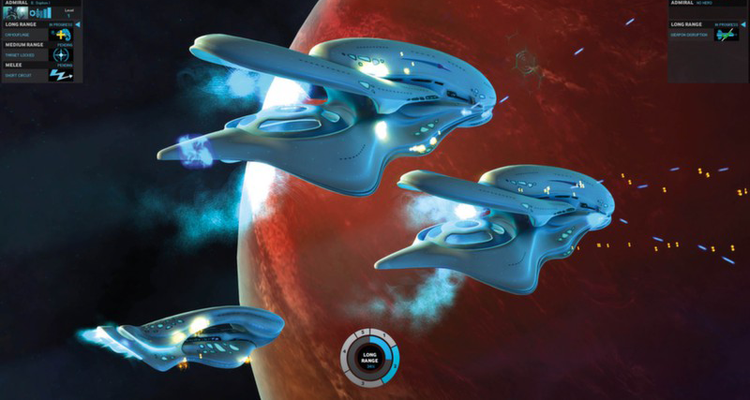Endless Space Provides Endless Opportunities – Game Review

Just when I thought my little empire was beginning to flourish, I got my butt kicked by Amoebas. All the work I’d put into research to make my planets ready for colonization? Gone. All my ships in my fleets? Destroyed. Even after my catastrophic defeat I watched my planets limp along as they tried to recover from invasion. The Amoebas blockaded me from trading or expanding; pirates flew through. Citizen satisfaction plummeted. And then the Amoebas struck the final blow and my first game of Endless Space was over.
Endless Space is a strategy game by Amplitude Studios, released on July 4th 2012. The game is set in a vast galaxy populated by varied species. The galaxy’s first intelligent life was the mysterious race called the Endless. They’ve since disappeared, but in their wake they’ve left Dust, a substance of immense worth and versatility. The empire that controls the Dust will control the galaxy.
The quest for Dust requires players to balance four main elements of colony commerce: Food, Industry, Dust, and Science (referred to as FIDS in-game). Through completing research the player may learn techniques necessary to colonize otherwise inhospitable planets, such as gas giants or desert planets. Production of industrial materials enables the building of ships; each player begins with certain ships available, but may upgrade designs and modify ships at their discretion, build them, and then send them out to colonize other star systems. These systems in turn require research in order to be colonized and flourish and become successful parts of your growing empire.
I hadn’t quite figured out how to colonize new systems, but I was feeling pretty confident about the size of my fleets and the balance in FIDS my star system had achieved when the Amoebas showed up. Another major element of Endless Space is the need for diplomacy and shrewd business deals. When I first made contact with the Amoebas (played by the AI) I had several ships deployed to defend my system. When I clicked the diplomacy settings I had the option to ignore the Amoebas, or go to war. I chose to go to war, not really thinking it through, which led to my downfall.
This another way in which Endless Space keeps you guessing. Whether you’re playing against an AI or against other players online, there’s an element you can’t control. That keeps the game exciting and interesting. Endless Space utilizes a turn-based system; during your turn you can select research to complete and planetary improvements to capitalize on Dust production. Each turn represents a year in the galaxy, and it can take several years to complete certain research or industrial production based on your output of science and industry. Each time you end a turn, the AI (or other players) are assessing their own research, output, and/or improvements. Without knowing what the opponent is doing, you have to rely on your own upgrades and political savvy to make your system, and eventually your empire, powerful.
In addition to the turn-based strategy system, Endless Space also incorporates RPG elements. As you grow your systems you gain access to Heroes to oversee the system. Each Hero has different skills and talents. These skills and talents can add bonuses to your fleets’ offense or defense, allow more efficient production of food, or make a system stronger politically and economically. Heroes level up and earn skill points; upgrading your Hero can improve the way your systems and fleets operate.
The battle system of Endless Space is another highlight of the game. There are two options for battle: the first is automatic, in which the computer calculates the battle based on fleet statistics for each side. The second is manual, in which the screen changes from the standard galactic overview of your empire and into a close-up real-time battle between you and the opponent. This view shows off Endless Space’s graphics. Images of alien ships, each unique to a race, attack your ships against a backdrop of stars, nebulae, and planets. Explosions fill the screen with every impact, making for an epic fight. A battle is three phases: ranged, midway, and close-up melee. Each phase requires quick strategic thinking and different sorts of weapons if you hope to be successful in your quest to dominate the galaxy.
In the end, Endless Space is about dominating the galaxy, but even if you have overcome your enemies and reign supreme, there are endless options for replay. Playing as different races opens up different options for colonization and ship-building. New systems have different Heroes available, and how you decide to upgrade your Hero can determine whether your success will be economic, political, and military. New research can improve Dust production or ship outfitting, and how and when you choose to do any of this is up to you. The enemy encounters will always be different, and there’s no going back once a turn has been taken. If playing against the AI you could try going back to an autosave point, but the encounters and outcomes will be different.
Endless Space’s Admiral Edition is available for $29.99 on Steam. The Admiral Edition provides a boost to your account on the Amplitude website, a unique in-game award, and the official digital soundtrack. A $5.00 upgrade gives you the Emperor Special Edition, which includes the perks of the Admiral Edition plus an extra skin pack for ships, and a Hero descended directly from the Endless. With its replay value, its expansive universe, and its countless options and strategies, Endless Space truly lives up to its name.






